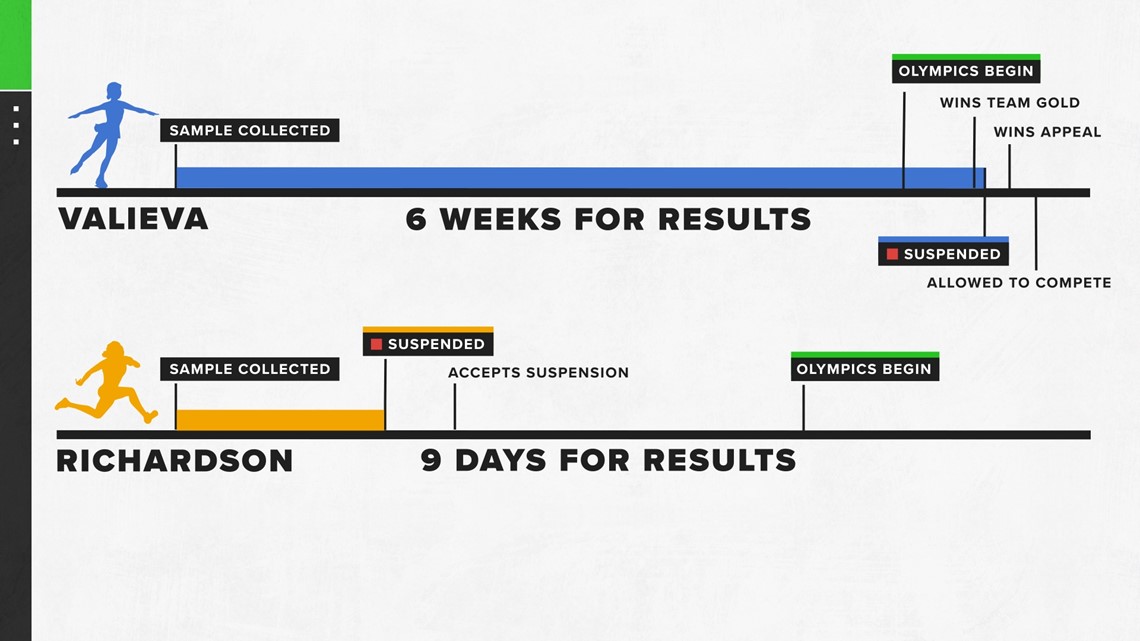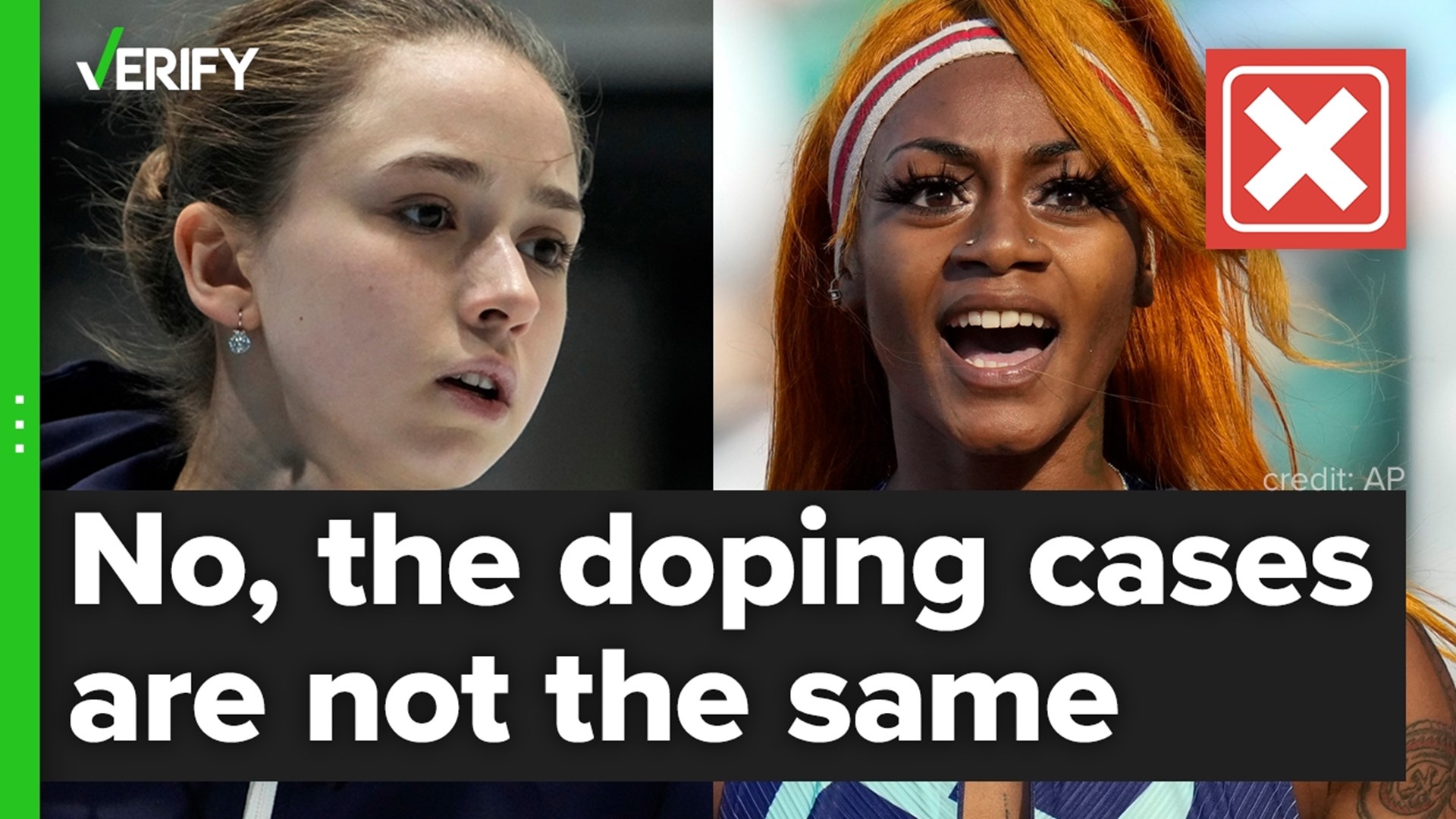Soon after the Russian Olympic Committee won gold in the Team Figure Skating event at Beijing 2022, a World Anti-Doping Agency (WADA) laboratory announced figure skater Kamila Valieva failed a December drug test for a performance-enhancing substance.
Although Valieva initially faced an automatic suspension that would keep her out the rest of the Olympics, she immediately appealed to the Russian Anti-Doping Agency (RUSADA) to lift her suspension — which RUSADA granted. That decision has since embroiled the Olympics in controversy because she was still scheduled to compete in one more event: the Women’s Single Skating event. She finished first in qualifying for the event on Feb. 15, and then finished in fourth in the finals on Feb. 17 — just short of a podium finish.
Rather than force her out of competition, the International Olympic Committee (IOC) announced it would not hold a medal ceremony if she finished on the podium in her event.
Many critics of the decision to allow her to continue compared her situation to U.S. track and field athlete Sha’Carri Richardson, who was unable to compete in the Tokyo Olympics after testing positive for marijuana during qualifiers. Several VERIFY viewers sent text messages and emails asking how the two situations were different, and how Valieva could continue to compete.
“Can we get a solid answer on the difference of her situation and mines?” Richardson herself asked in a tweet. “The only difference I see is I’m a black young lady.”
THE QUESTION
What are the differences between Sha'Carri Richardson's suspension and Kamila Valieva's case?
THE SOURCES
WHAT WE FOUND
While Sha’Carri Richardson’s case was fairly straightforward, many of the details of Kamila Valieva’s case were highly unusual.
U.S. anti-doping officials reported Richardson’s positive test less than two weeks after she tested. They suspended her for 30 days, and nullified her results on the date of the positive results — results that would have qualified her for the Olympics. She accepted the suspension and disqualifications without any appeals.
Although Valieva, who is a minor at 15-years-old, was also tested during the Olympic qualifying period, her results weren’t reported by anti-doping officials until six weeks later, once the Olympics had already started. Russia’s anti-doping officials issued an automatic suspension at first, but Valieva appealed it and her suspension was lifted. Global sports officials, including the International Olympic Committee (IOC), appealed to reinstate the suspension, but the Court of Arbitration for Sport (CAS) sided with Valieva — an already rare decision made even rarer by its timing during the Olympics.
Kamila Valieva
Kamila Valieva, a 15-year-old Russian figure skater, tested positive for trimetazidine, a prohibited substance by the World Anti-Doping Agency (WADA), on Dec. 25, 2021, according to the International Testing Agency (ITA). A WADA-accredited laboratory reported to the Russian Anti-Doping Agency (RUSADA) on Feb. 8, 2022, that Valieva had failed that drug test. Her positive test was not known to any sporting authority or agency before this date.
According to a statement released by the WADA, it expects national anti-doping agencies to work with laboratories to expedite testing for samples of athletes with upcoming competitions. The WADA says the Russian Anti-Doping Agency (RUSADA) did not flag Valieva’s sample as a priority sample, which meant the laboratory did not know it needed to fast-track its testing.
The WADA code directs national anti-doping agencies to automatically suspend an athlete temporarily after such a test until a case is fully investigated, which RUSADA did following the laboratory’s report of Valieva’s positive test result. Valieva then appealed the automatic suspension, and RUSADA agreed to lift it.
The ITA said the IOC could not issue its own decision on Valieva’s eligibility because the drug test was from before the Olympics, even though it wasn’t reported until after the Olympics had already begun.
“As the sample was collected by RUSADA ahead of the Winter Games, this case is not under the jurisdiction of the IOC and thus not directly managed by the ITA,” the ITA, which is leading Beijing 2022’s anti-doping program, said.
On Feb. 11, WADA, the IOC and the International Skating Union (ISU) chose to appeal to the CAS to overturn RUSADA’s ruling and keep Valieva suspended. On Feb. 14, CAS sided with RUSADA and Valieva, in part because she is a “protected person” as a minor and because her positive test still needs further investigation before it’s confirmed she violated the rules.
“It's pretty unusual for a provisional suspension to be set aside by any agency, the rules make it so that it's pretty difficult to do,” said Howard Jacobs, a sports lawyer with an expertise in athlete doping cases. “To have it all happen in the middle of the Olympics — I don't think it's ever happened.”
WADA said it was “disappointed” by the CAS ruling, and countered that its code does not exempt minors from mandatory provisional suspensions. The IOC agreed to abide by the ruling, but said it would not conduct a medal ceremony if Valieva finished in the top three in her remaining event — which would have meant anyone else who finished on the podium would also not have experienced a medal ceremony. The IOC also asked the ISU to allow an additional competitor in Valieva’s event so she doesn’t take the spot of another athlete, which the ISU agreed to.
The ITA said a decision on whether Valieva and her team’s results will stand is still pending, and can only be made after Valieva’s test is fully investigated. That means it’s still possible her results can be nullified later even though she is allowed to continue competing.
Jacobs said the investigation will look into Valieva’s circumstances, and where the banned substance came from. Once the investigation is complete, he said, the ISU will decide if she’s suspended from competition, what the length of her suspension is and if her results between the positive test and her suspension should be nullified.
Sha’Carri Richardson
Richardson’s suspension, on the other hand, was handled by American authorities in a far more typical fashion than how Valieva’s case has been handled.
“The rules were essentially followed in [Richardson]’s case,” Jacobs said.
The U.S. Anti-Doping Agency (USADA) found THC in Richardson’s sample taken at the U.S. Olympic Team Trials in June 2021, where she would have qualified for the Tokyo Olympics. Richardson publicly said she ingested marijuana in Oregon, where it’s legal, while coping with the death of her biological mother.
Richardson accepted the one-month suspension USADA imposed upon her, a contrast to Valieva who immediately appealed her own suspension. It also disqualified her results for that day, including her Olympic qualifying results for individual events.
That left her only able to qualify for the Olympics through selection to the Women’s 4x100-Meter Relay, which USADA said her eligibility would be determined by USA Track & Field. USA Track & Field said it would not include Richardson for the Women’s 4x100-Meter Relay team in a statement released July 6, 2021.
“I think from the date of the positive tests until she accepted the sanction was maybe two weeks,” Jacobs said. “And that's how it's supposed to happen during an Olympic trials or competition that is pre-Olympics.”


International sporting bodies, like the IOC and WADA, did not make a decision on Richardson’s eligibility for the Tokyo Olympics, nor did they get a final say in Valieva’s eligibility for the Beijing Olympics. Since Richardson accepted her suspension, her case never had an opportunity to be heard before the Court of Arbitration for Sport like Valieva’s case was.
More from VERIFY: Yes, the Olympics and NBC can block your Olympic videos on social media

